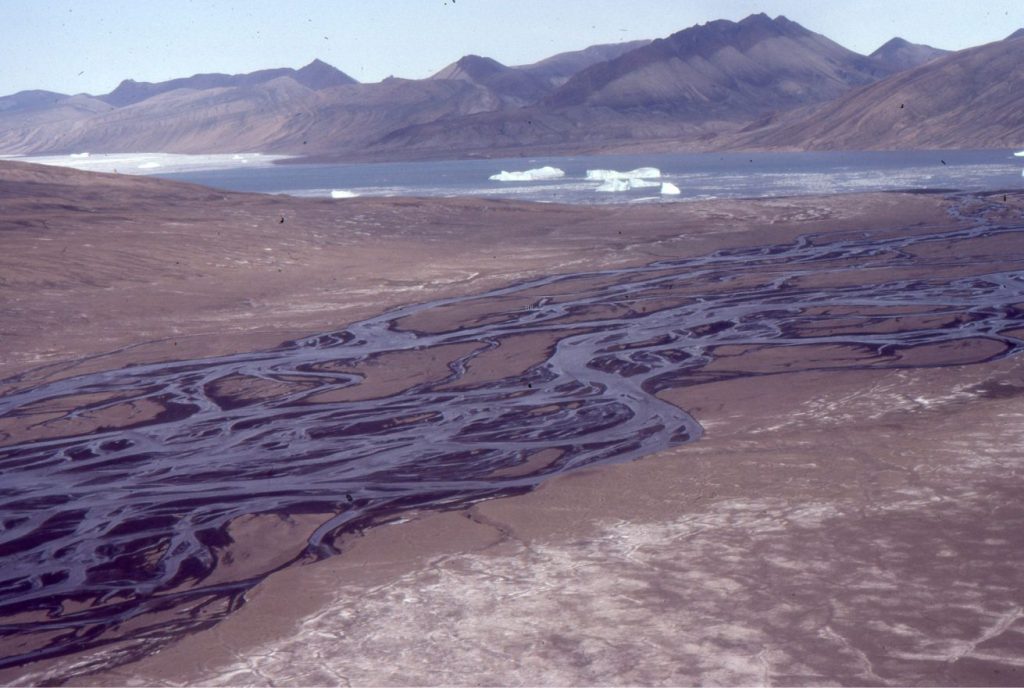
Featuring tabular, trough, and horizontally crossbedded gravels
General occurrence
Tabular and trough crossbedding in gravel and mixed sand-gravel deposits are comparable to their sandy counterparts in some respects:
- The basis for defining them as tabular and trough bedforms uses the same criteria, namely the 2D and 3D geometry of their lower crossbed set boundaries – planar and spoon-shaped respectively.
- Trough, tabular (and horizontal bedded) gravels are closely associated in fluvial-alluvial depositional systems.
- They are a response to bedload transport of sediment, under conditions that vary from subcritical to supercritical flow.
The main point of departure from these commonalities is the significantly greater shear stresses required to entrain clasts >2 mm diameter, particularly for pebble and coarser clast sizes. In many cases, such flows will be Froude supercritical. Furthermore, in natural channels and sheet flow there is much variation in flow velocity (and bed shear) from one part of a channel to another, where flow fluctuates between supercritical to subcritical. Whereas the bedload movement of sand may be relatively continuous under subcritical (lower flow regime) conditions, the transport of gravel will likely be discontinuous.
Tabular and trough crossbedded gravel lithofacies
Tabular and trough crossbeds are assigned to separate lithofacies, but here are treated together.
External structure
Tabular and trough crossbedded gravel bedforms tend to be larger than their sandy counterparts by virtue of their grain size. The best place to observe them in their entirety is in river and alluvial fan channels during low flow conditions. In coarse-grained braided systems, tabular crossbeds are one of the foundational structures of within-channel bars. Note however that most channel bars are complex amalgams of overlapping, discordant, and truncated tabular and trough crossbed sets rather than a single bedform, because of changing flow directions and flow competences as channel discharges wax and wane. Unlike their sandy counterparts, identification of 2D and 3D bedform geometries is more difficult. In reality, confident identification of either tabular or trough gravel bedforms requires cross-section exposure of foresets and crossbed set boundaries.
Internal structure
Tabular foresets are generally planar or slightly concave upward, dipping 20o-30o. Trough crossbed foresets are more spoon-shaped, mimicking to some extent the trough-like lower boundary. Crossbed set thickness generally ranges from a few decimetres to 3 metres and more. Grain-size grading is common where the largest clasts occur at the base of foresets, becoming finer-grained up dip. Clast-supported frameworks predominate. Successive crossbed sets of both types truncate earlier formed sets.
Unfortunately, in real world exposures crossbedding can be difficult to discern because the grain-size range along a single gravel foreset and among groups of foresets commonly ranges over two and even three orders of magnitude (keep in mind the Wentworth grain-size scale is logarithmic). If you want to decipher sedimentary structures in gravel deposits, you really do need to stand back from the outcrop.
Two sedimentary structures provide some relief from this dilemma.
- Thin sandy deposits on foresets provide good contrast in grain size within the gravel accumulations, and
- Imbrication or alignment of platy and oblate clasts along foreset planes.
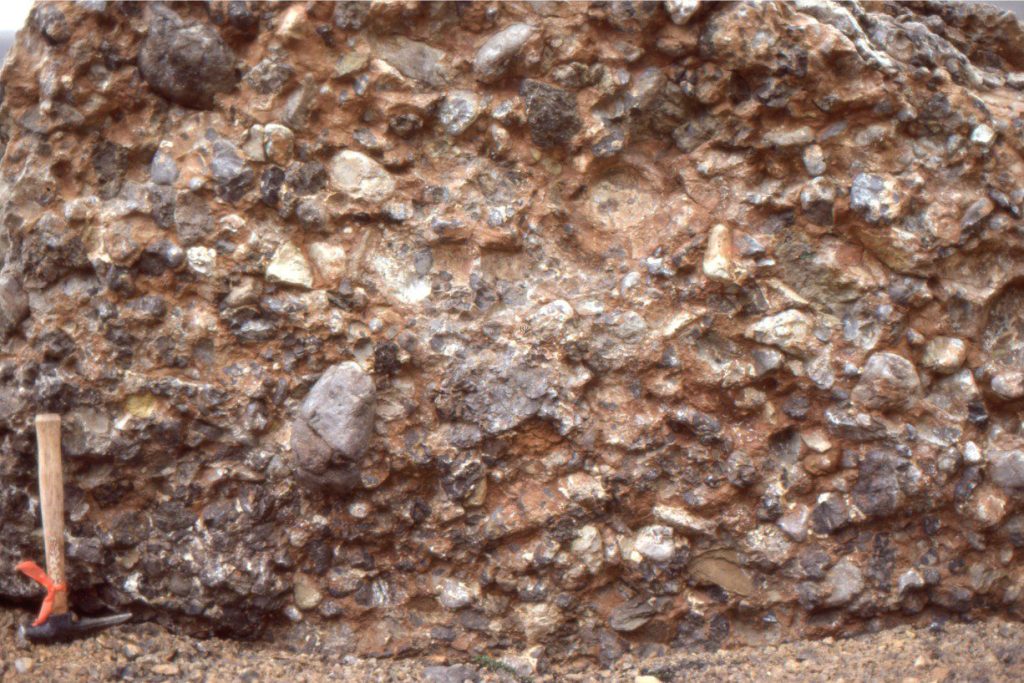

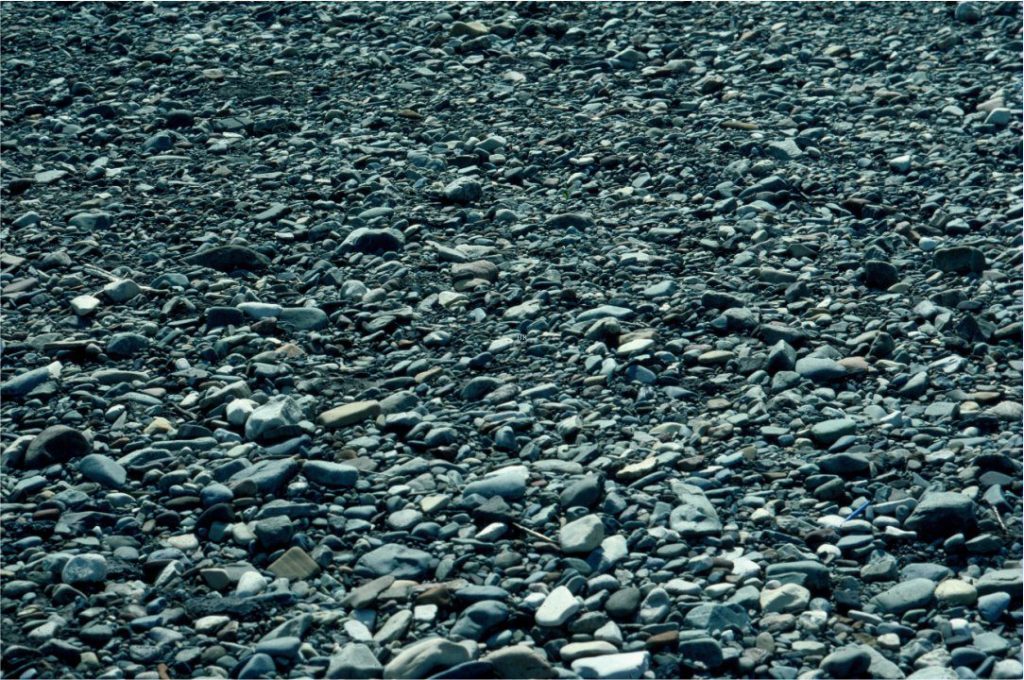
Formation – hydrodynamic conditions
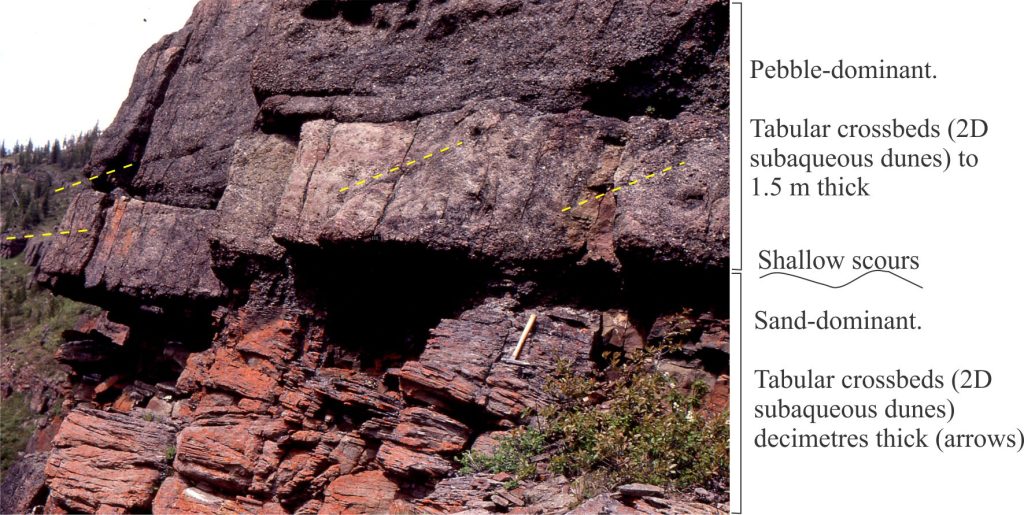
Tabular and trough bedforms in gravels develop from bedload transport – a combination of traction carpet and saltation load. For this to take place, flow velocities must be high enough to initiate (entrain) and maintain grain movement. For entrainment to begin, the shear stresses generated by flow of water over a sediment bed must be greater than the combined forces of gravity and frictional drag; these are referred to as critical stresses. Some of the variables that influence critical stress include:
- Flow characteristics at the water-bed interface. In most natural flows this will involve turbulence.
- Flow velocities.
- Clast diameter; large clasts will have a greater surface area exposed to flow than their smaller neighbours.
- Clast density.
- Clast shape; spherical clasts will roll more easily than platy clasts of the same diameter and density (Cassel et al., 2021, Open access).
- Overall bed roughness, or the degree to which some grains stand proud against their nearest neighbours, is determined by grain size, sorting, and clast packing.
Bed roughness can have a significant impact on clast entrainment. In a gravel bed where size sorting is relatively poor (a common feature of gravels), smaller clasts trapped by larger neighbours will not move until the larger clast is dislodged. This means that some sections of a gravel bed may be static, while other sections are on the move.
Assuming entrainment is in full swing, clasts will roll, bounce, and jostle their way along the top of the submerged bar or bedform. Clasts will cascade down the lee face. Tabular crossbedding is the most common type formed in this way. Any entrained sand will probably be swept beyond the lee face but may fall out of suspension in the backflow eddies because of reduced flow competence.
The rate at which bars and bedforms migrate downstream is also dependent on sediment supply (e.g., Nelson and Morgan, 2018). There are three main sources of coarse- (and fine) grained material:
- Newly introduced sediment from upstream sources such as alluvial fans during floods or peak flow during spring thaw.
- Erosion and collapse of channel margins (e.g., older channel deposits). Supply of this kind will be discontinuous.
- Reworking of material from within-channel bars during peak flow as channels migrate laterally or on bars dissected by chutes.

Common environments
We generally associate these lithofacies with gravel-bed fluvial channels in low sinuosity river systems. Alluvial fans may also contain ephemeral, braided channels. In both cases, within-channel transverse, point, and longitudinal bars consist mostly of amalgamated, tabular crossbedded lithofacies, with the trough crossbedded lithofacies created by scouring in pools that form at the junction of active channels (see N. Smith, 1974 for one of the first descriptions of these bar types – PDF available). These conditions also apply to glaciofluvial environments, and to fluvial channels on continental shelves or platforms that are exposed during sea level lowstand.
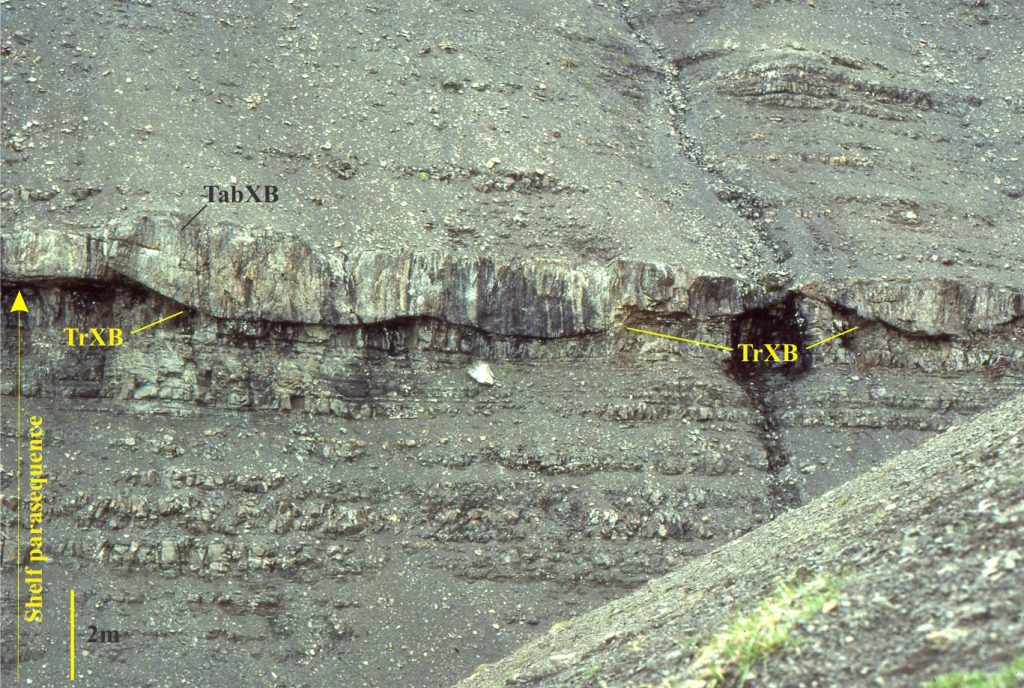
Fluvial channels that supply sand to the topset beds of coarse-grained fan deltas contain both lithofacies. Larger versions of the tabular crossbedded gravels also resemble the foreset layers of Gilbert deltas.
Beach storm ridge gravels tend to be structureless internally but may develop crude tabular crossbeds if the gravels are pushed landward. In this case the foresets will dip landward. Associated lithofacies and biofacies will provide a reasonable basis for making the distinction between beach settings and fluvial, glaciofluvial, and fan delta environments.
Horizontally bedded gravel lithofacies
The lithofacies is included in this post because in coarse-grained fluvial deposits it is associated with the crossbed lithofacies, as a bedform itself and as a transitional or precursor bedform to tabular crossbedded gravels (Hein and Walker, 1977 PDF available; Miall, 2006).
External structure
The lithofacies consists of flat bedded, low relief gravels deposited as diffuse sheets. They are generally a few decimetres thick.
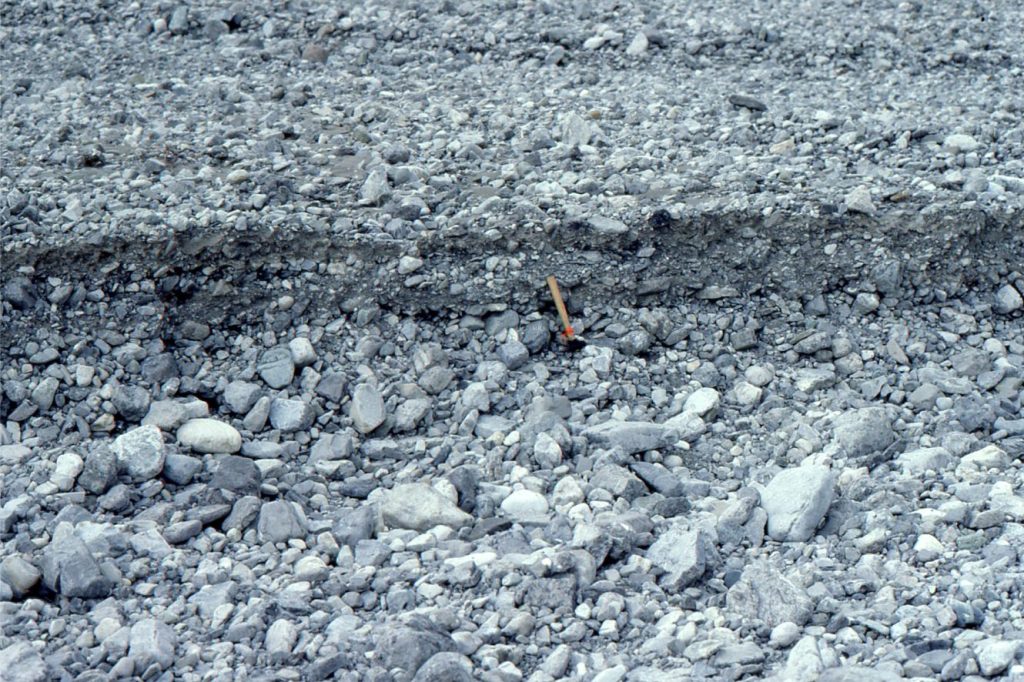
Internal structure
Stratification mimics the external bedform geometry and thus tends to be flat with very low-angle, downstream dip. Stratification tends to be crude and in coarser gravels may not be easily identified, although it may be enhanced by clast imbrication. Clast-supported frameworks predominate. In most deposits the sand matrix has infiltrated clast interstices during low flow conditions.
Formation – hydrodynamic conditions
Based on their observations of bar development in Kicking Horse River, Hein and Walker (1977) inferred that these bedforms developed during peak flows as a gravel lag one to two clasts thick. If the supply of clasts is high then the sheets aggrade, but their overall geometry does not change. The overall effect is the development of flat, horizontal or low angle stratification. If clast supply rates remain high, then the gravel sheet will also expand downstream.
In the Hein and Walker model, lower rates of sediment supply also result in vertical aggradation of the bedform but in this case a lee or slip face develops at the downstream end of the gravel sheet. Clasts that tumble down the slip face will contribute to the development of tabular foresets. Thus, if the Hein and Walker hypothesis is correct, horizontal bedded sheets and bars can act as a precursor to tabular crossbedded bars.

Common environments
Like the tabular and trough crossbed lithofacies, there is a general expectation that these gravel sheets occur in coarse-grained river and ephemeral alluvial fan channels, including channels that transport sediment across fan delta topsets.
Low-angle and horizontally bedded gravels also occur in marine shoreface and beach deposits. However, the association with other lithofacies and biofacies in these environments should serve to distinguish them from fluvial-dominated settings.
Other posts in this series
Sandstone lithofacies
Ripple lithofacies: Ubiquitous bedforms
Ripple lithofacies influenced by tides
Tabular and trough crossbed lithofacies
Laminated sandstone lithofacies
Low-angle crossbedded sandstone
Hummocky and swaley cross-stratification
Lithofacies beyond supercritical antidunes
Subaqueous dunes influenced by tides
Gravel lithofacies
Introducing coarse-grained lithofacies

















